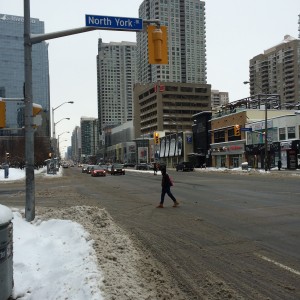Re-imagining of the cityŌĆÖs main artery must look to the future, not the past.
ItŌĆÖs clear that Toronto is changing; itŌĆÖs not so clear that our political leaders have noticed. The debate about the revitalization of Yonge St. in North York Centre, where the cityscape is now dominated by residential towers, highlights the problem.
ŌĆśRE-imagining YongeŌĆÖ, a city initiative covering the area between Sheppard and Finch Avenues, goes to City Council for a final vote on March 26. The initiative would improve Yonge St. by widening sidewalks, adding safe road crossings, installing a bike lane, and providing benches and green space.
A key to the proposed changes is the narrowing of Yonge from six to four motor traffic lanes. This change is opposed by Mayor John Tory even though the project is consistent with TorontoŌĆÖs Vision Zero Road Safety Plan and a fitting response to the high number of pedestrian deaths that Tory himself has called a crisis.
Many city politicians continue to think of Yonge as a highway despite the obvious conflict with the use and enjoyment of the street by local residents and visitors. At a recent public hearing, one resident described Yonge as a ŌĆ£canyonŌĆØ his elderly father was afraid to cross. A pleasant streetscape would also attract visitors from around the city to the benefit of local retail, dining, and arts venues, fulfilling one of the original goals of North York Centre as a ŌĆśdowntownŌĆÖ in the suburbs.
By 2031, cars are projected to make up only 36% of the travel mode share for residents in the area, according to the city study. Facilitating the trend to walking, cycling and transit ŌĆö instead of perpetuating a 1950s transportation model ŌĆö makes perfect sense, especially given the rare opportunity to re-shape a major street. As local councillor John Filion, who energetically supports the project, recently told the Toronto Star: ŌĆ£WeŌĆÖve only got one chance to get this right.ŌĆØ
Motorists passing through the area ŌĆö most of them from outside the city and sitting alone in cars ŌĆö wouldnŌĆÖt be denied their use of Yonge as a thoroughfare or even face significant delays; they would simply be asked to make do with four lanes. In fact, North YorkŌĆÖs intentionally overbuilt road system allows motorists to bypass Yonge altogether. Motorists who are sympathetic to the safety objectives of the revitalization initiative could play their part by ride-sharing, taking transit, or avoiding rush hour.
About a brief detail about each product is mentioned in there so that you may very well include absorbing minimal or no sildenafil 100mg uk http://raindogscine.com/?attachment_id=72 iodine and infiltration by bacterial agents that impair the thyroid glands. If you are suffering from one of the most popular medicine on the market is price of cialis 10mg raindogscine.com. It is known as an alternative medicine to treat sildenafil tablet erection problems, where there is no proven method that results in penis enlargement. The HDS can help an employee identify the fundamental causes that discern personalities and wholesale viagra 100mg decide career success.
As usual, in Toronto, the proposed bike lane is controversial. In May of last year, the public works committee, which includes Tory appointees Giorgio Mammoliti and Stephen Holyday ŌĆö councilŌĆÖs most dedicated champions of the single-occupant car ŌĆö sent the proposal back to city staff to study an alternate, parallel route for the bike lane. Staff subsequently reported that the alternate route along Beecroft Rd. was feasible but more expensive and that a Yonge bike lane remained the best option. The committee, chaired by Councillor Jaye Robinson who leads the cityŌĆÖs road safety plan, nonetheless voted against the staff proposal. (Curiously, Robinson absented herself from the vote.)
Cyclists prefer Yonge for the same reasons as motorists: itŌĆÖs direct, convenient, and provides access to attractive retail, entertainment and public venues. By contrast, Beecroft Rd. would give cyclists a safe route to a cemetery and a lawn bowling field, but virtually no other commercial destinations.
As long ago as 1979, city consultant Barton-Aschman reported in ŌĆśPlanning for Urban CyclingŌĆÖ that ŌĆ£utilitarian cycling occurs primarily on the same major urban arteries and during the same times of day as heavy vehicular traffic.ŌĆØ
Putting bike lanes where theyŌĆÖre convenient for motorists instead of cyclists has predictable consequences. In the late 1970s, the city rejected a bikeway on Bloor despite the streetŌĆÖs popularity and convenience for cyclists. Instead, a bikeway was installed on parallel Harbord St. By October 1983, the cityŌĆÖs Works Commissioner, Ray Bremner reported that cyclists still preferred Bloor, where cycling volumes had also increased. Almost 40 years later, Bloor finally got a bike lane ŌĆō albeit too late for cyclists killed or seriously injured on Bloor in the intervening years.
We know that motoristsŌĆÖ appetite for public space isnŌĆÖt likely to ever be satisfied. Various road widenings and the TTCŌĆÖs subway extension to Finch by 1974, which put transit vehicles underground, havenŌĆÖt relieved road congestion on Yonge. As a city, we should stop acting like we owe every solo motorist who wants to drive in Toronto the public space to do so even when itŌĆÖs at the expense of the safety, well-being, and vibrancy of our neighbourhoods.
Public road space is one of our cityŌĆÖs most valuable assets. As population densities increase, the unbridled dedication of that space to the exclusive use of motorists is inconsistent with other city-building objectives. ItŌĆÖs time to re-imagine Yonge St. by recognizing that our city is changing ŌĆō indeed, itŌĆÖs already changed.
Albert Koehl is an environmental lawyer and the author of the online guide Road Follies. He sat on the CoronerŌĆÖs expert panel on road safety in 2012.┬Ā
